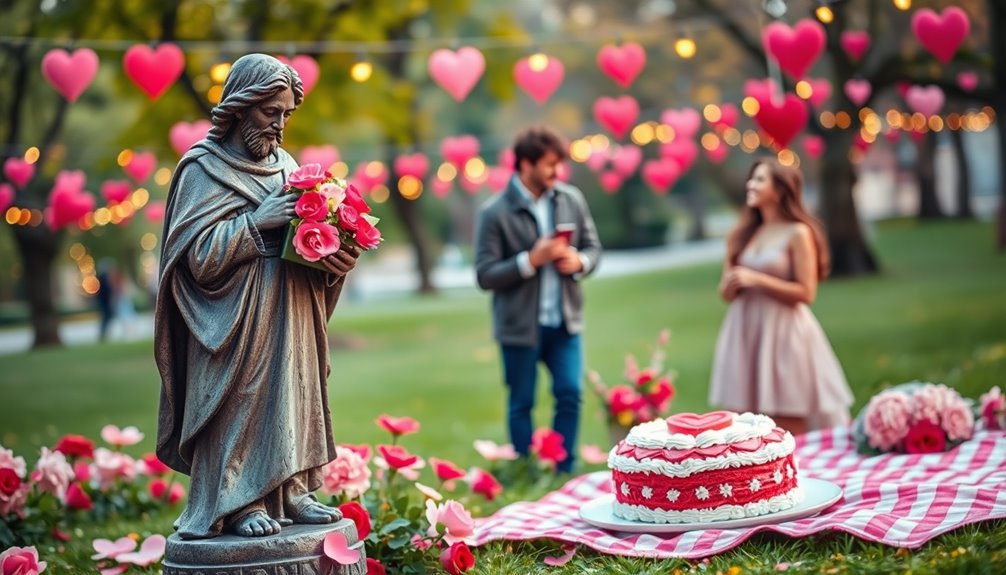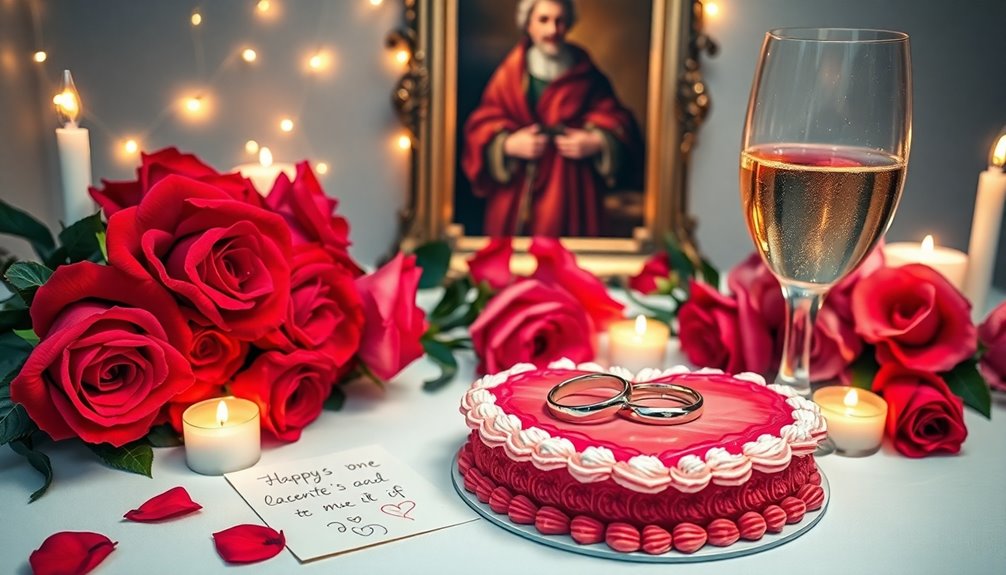Valentine's Day honors Saint Valentine, a Roman priest who defied Emperor Claudius II by secretly marrying couples during a ban on soldier marriages. His courageous actions symbolized love and sacrifice, leading to his martyrdom. Celebrated on February 14, the day evolved from ancient Roman festivals into a holiday emphasizing romantic love, largely influenced by writers like Chaucer. Today, it serves as a reminder of love's power, with many traditions reflecting its diverse expressions. There's so much more to explore about this fascinating celebration!
Key Takeaways
- Saint Valentine was a Roman priest who secretly married couples during Emperor Claudius II's ban, symbolizing love and sacrifice.
- His martyrdom for defying the emperor's orders led to his recognition as the patron saint of lovers.
- Valentine's Day evolved from ancient Roman festivals, combining themes of love and fertility with the legacy of Saint Valentine.
- The day is celebrated globally, emphasizing love in various forms, including romantic relationships and friendships.
- Valentine's Day highlights the importance of love and sacrifice, reflecting changing societal values and expressions of affection.

Valentine's Day is more than just a date on the calendar; it's a celebration steeped in history and tradition. At its core lies the figure of Saint Valentine, a Roman priest and physician from the third century. You mightn't know that he lived during a tumultuous time when Emperor Claudius II Gothicus persecuted Christians.
Saint Valentine courageously ministered to those in hiding and secretly performed marriages for couples, defying the emperor's ban on marriage for soldiers. This act wasn't just a rebellion against authority; it was a profound gesture of love and sacrifice, making him a martyr. His feast day is celebrated on February 14, which has become synonymous with love and romance.
So, why do we honor Saint Valentine today? His legacy as the patron saint of lovers, epilepsy, and beekeepers stems from his selfless actions during a dark period. By marrying couples in secret, he not only stood against unjust laws but also fostered a sense of hope and love among the people.
The early Christians embraced his story, weaving it into their traditions that emphasized love's power and the spirit of sacrifice. Valentine's Day evolved from ancient Roman festivals like Lupercalia, which celebrated love and fertility.
As Christianity gained a foothold, the holiday transformed to commemorate Saint Valentine’s martyrdom. The Middle Ages saw the rise of courtly love, further entrenching the day in romantic ideals. Writers like Chaucer and Shakespeare helped romanticize Valentine’s Day, making it synonymous with expressing romantic feelings. This cultural evolution led to the exchange of love notes and tokens of affection, which are still practiced today. In modern times, Valentine’s Day has not only become a celebration of romantic love, but it also serves as an occasion to cherish friendships and familial bonds. To take this celebration to another level, many opt for self-care and relaxation, looking for ways to transform your spa experience into a day of indulgence and rejuvenation.
Today, Valentine's Day has become a global phenomenon, celebrated in diverse ways across cultures. It has significant economic impact due to gift-giving and commercial activities, with symbols like Cupid and red roses taking center stage.
As the celebration continues to evolve, new traditions like Galentine's Day emerge, allowing you to celebrate friendships just as passionately. Ultimately, Valentine's Day remains a timeless reminder of love in all its forms, echoing the spirit of Saint Valentine himself.
Frequently Asked Questions
What Are Common Symbols Associated With Valentine's Day?
When you think of Valentine's Day, several symbols come to mind. Red roses represent deep love and passion, while hearts convey emotions.
Cupid, often depicted as a cherubic figure, symbolizes love's unpredictable nature. Love knots signify eternal commitment, and Valentine's Day cards help you express your feelings to loved ones.
These symbols have evolved over time but remain central to how you celebrate this special day.
How Do Different Cultures Celebrate Valentine's Day?
You might be surprised to discover how diverse Valentine's Day celebrations can be around the world.
In South Korea, you get to enjoy White Day, where men return gifts to women.
In China, you celebrate the Qixi Festival, honoring a heartfelt love story.
Meanwhile, in Ireland, many embark on pilgrimages to the Shrine of St. Valentine, seeking love.
Each culture brings its own unique flair, making this day a vibrant celebration of affection and connection.
What Are Popular Gifts for Valentine's Day?
When you're choosing gifts for Valentine's Day, you can't go wrong with classics like red roses, chocolates, or jewelry.
If you want something more personal, consider handmade items or customized gifts like photo albums.
Experiences, like a romantic dinner or weekend getaway, also make great choices.
For a unique touch, handcrafted crafts or modern trends like Galentine's Day gifts are increasingly popular.
Just think about what'll make your loved one smile!
When Did Valentine's Day First Become Widely Celebrated?
Valentine's Day first became widely celebrated in the 14th century, primarily due to Geoffrey Chaucer's writings that linked the day to romantic love.
By the 18th century, it evolved into an occasion for exchanging gifts and cards in England.
As the years passed, the holiday gained popularity through cultural exchanges, transforming from a Christian feast day into the beloved celebration of love we know today.
You'll find various traditions worldwide now!
Are There Any Modern Controversies Surrounding Valentine's Day?
Yes, there are modern controversies surrounding Valentine's Day.
You might feel pressure to conform to societal expectations, leading to stress or loneliness if you're single.
Some critics argue that the holiday promotes commercialization, overshadowing genuine expressions of love.
Additionally, certain religious leaders see it as conflicting with traditional values.
As you navigate these complexities, consider celebrating love in ways that resonate with you, whether through friendship, family, or self-care.
Conclusion
So, as you celebrate Valentine's Day, remember it's more than just flowers and chocolates. It's a tapestry woven from the threads of love, sacrifice, and devotion that Saint Valentine embodied. Each heartfelt message you send echoes his spirit, reminding you that love, in all its forms, is worth honoring. As you embrace this day, let your connections shine like stars in the night sky, illuminating the beauty of affection that binds us all together.









